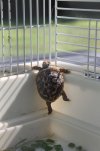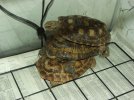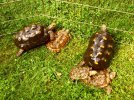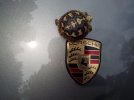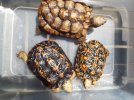Sam & Ella
Member
New member. I have two female redfoots, "Samantha and Ella" since hatchlings in 1997. 1998: Twin hatch, male female pancakes, colonized to 12 now. The redfoots are 13 pounds. They stay outside in the summer in a big pen with a timer-heated DogGloo.
The original M-F pancakes (Flapjackie and Buckwheat) are 7" and one pound. Flapjackie and three of her "daughters" usually lay twin eggs, and the last six hatches have been females (higher incubation temp)! Never had twin eggs both hatch yet.
Note: A name brand commercial tortoise "daily diet" food costs about $1.08 per ounce. I found VERY similar ingredients and vitamins and similar percentages in a name brand rabbit food, which I pulverize in a food blender and sprinkle heavily on wet, fresh greens and veggies. The rabbit food is 13.3 cents an ounce. What's the downside of that?
The original M-F pancakes (Flapjackie and Buckwheat) are 7" and one pound. Flapjackie and three of her "daughters" usually lay twin eggs, and the last six hatches have been females (higher incubation temp)! Never had twin eggs both hatch yet.
Note: A name brand commercial tortoise "daily diet" food costs about $1.08 per ounce. I found VERY similar ingredients and vitamins and similar percentages in a name brand rabbit food, which I pulverize in a food blender and sprinkle heavily on wet, fresh greens and veggies. The rabbit food is 13.3 cents an ounce. What's the downside of that?
